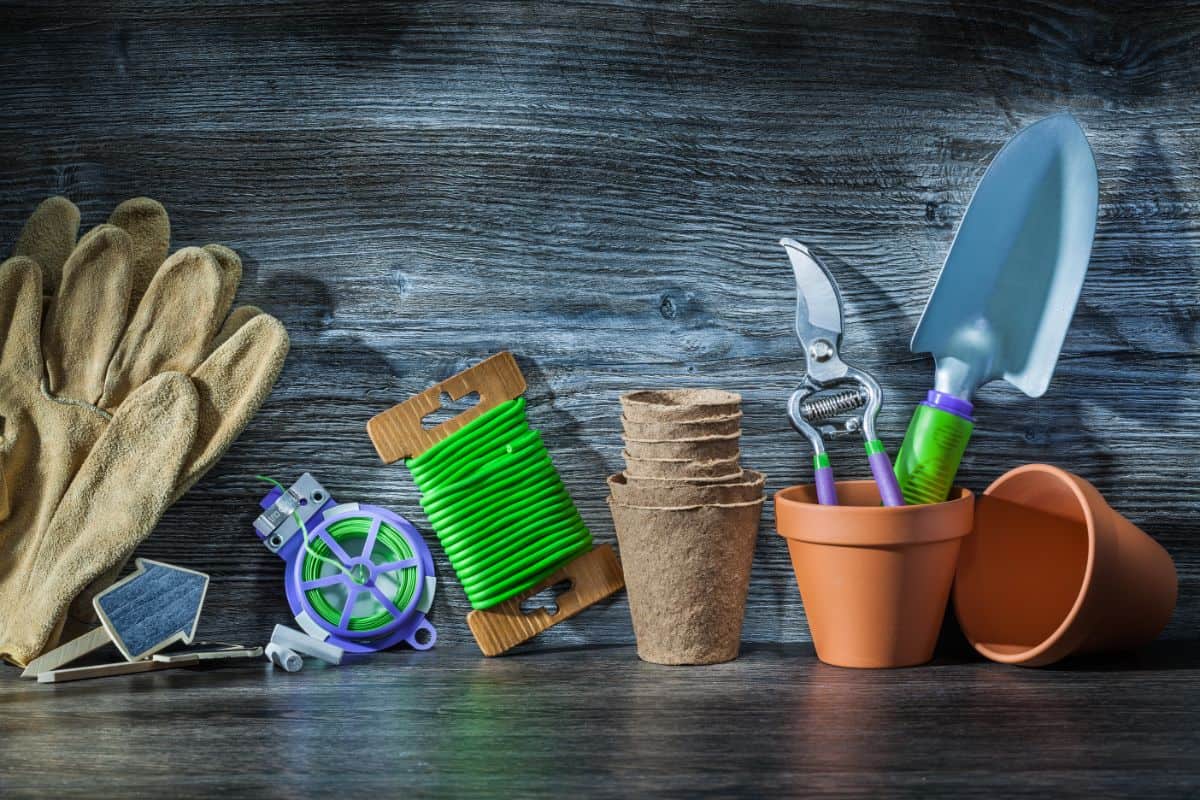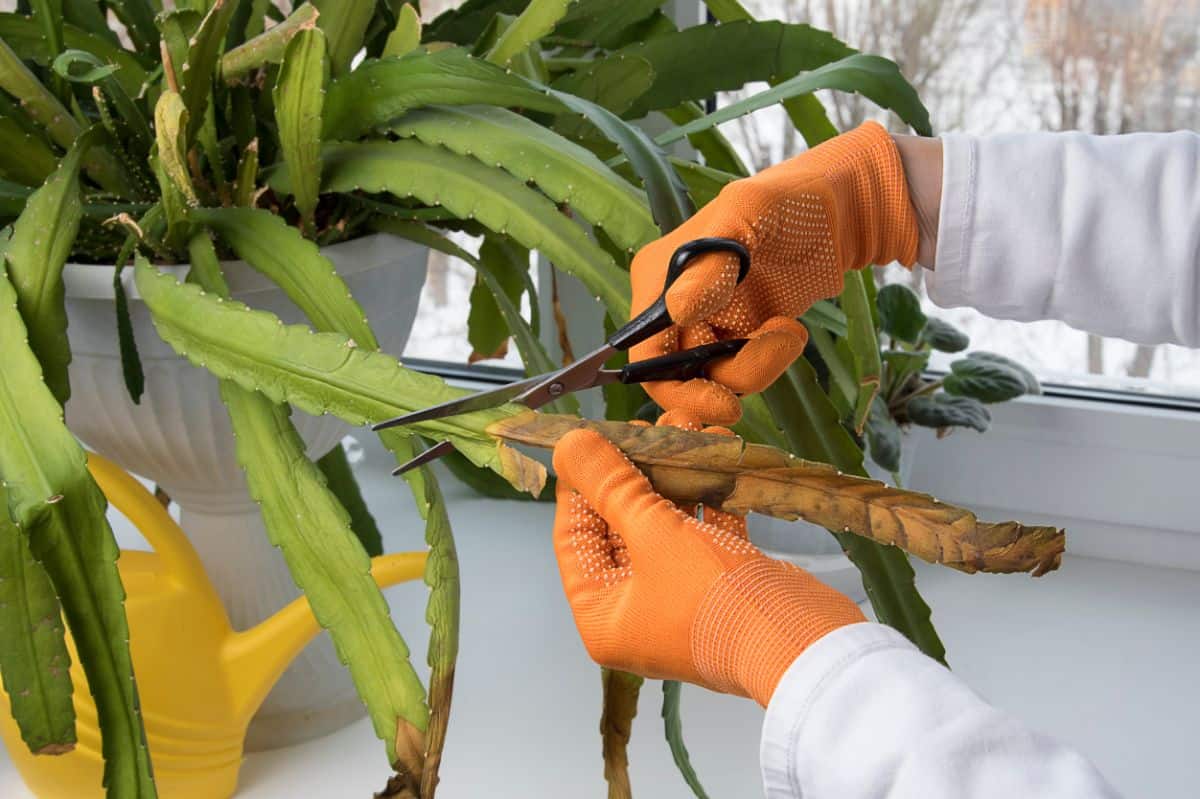Every beginner is going to be afraid of the first big trim. A brand-new succulent has gotten too tall or maybe you want some branching, or perhaps there is even disease to fight. There are many reasons to trim your succulents and cacti.

Before you make that first snip, you will want to read through this guide on how to trim your cacti. The next post on Cacti Trimming 101, is going to be The Why. This post is going to cover why you should trim your cacti, the diseases to watch for, and some aesthetic trimming advice. Both The How and The Why are going to be great guides that will give you confidence as a gardener.
Let’s dive in!
Jump to:
Step-by-Step Guide on How to trim Cacti
Trimming a cactus isn’t as nerve-wracking as many people think it is. Some plants are easy to trim and others can require a saw to get through. So how do you trim a cactus?
Very carefully!
At every stage of caring for a succulent, especially cacti, you need to have the right tools for your safety. Some cacti have glochids which are very fine hairs on the cactus: they can get caught in your ears, eyes, and nose: they can quickly cause inflammation wherever they poke. Best to be prepared!
What to Do
If you follow these four steps to cut your cacti, you will be sure to have a thriving, healthy cactus after a proper trim!
Step One – Gather and Sanitize

You will need to gather the following tools:
- Bleach
- Bucket
- Water
- Goggles or Eye Protection
- Clothes that cover your skin
- Closed toe shoes
- Nippers
- Saw (optional)
- Paper towels or white washcloth
- Cardboard
No products found.
To sanitize your tools ( a very necessary step ), you will need a 10% bleach solution. To make this solution, add one part bleach to ten parts water in the bucket. Soak any tools that will come into contact with the flesh of the cactus for about ten minutes. Once the tools have finished soaking, dry them with the white washcloth or paper towels.
Once your tools are clean, suit up in your eye protection, gloves, and clothes that cover your skin. This will be necessary to protect you from the spines as well as the juice that cacti produce: this byproduct can cause a great deal of irritation, redness, and inflammation if it touches your skin.
Step Two – What to Trim

This is the step before what most people consider the scariest step! Before you even let a single blade touch your cactus, you need to determine what it is that you want to trim. Are you looking to reshape the entire cactus? Are you doing a yearly trim? Or are you trying to take care of a disease? All of these are questions that you must ask yourself before starting to cut away at the cactus.
If you are trimming to a set height, then you want to plan what pieces of your cacti you will need to cut. You can mark them with small cuts in the flesh with a sanitized knife if need be. Marking the cactus allows you to have a nice, even line if that is what you are looking for.
The next part to look at is how do you want blooms to appear? If your cactus blooms (as many do), then you want to determine how you are going to get more blooms. This is done by regularly trimming your cactus by about ⅓ of its height every year.
Branched, Barrel, Columnar, Offshoots and Paddles
Before moving to the next step, you will also need to determine what kind of plant you are working with. Some cacti are going to have branches, some will be straight, others will have many offshoots, and some will also have paddles. There’s a way to take care and trim each of these types of cacti.
If you have a cacti that is naturally sectioned off in paddles, pinecones, or pylons, then the best place to cut them is going to be at the base of a section rather than cutting it off in the middle of a section. This is pretty much the same for any type of segmented cacti.
If your cactus is columnar or branched columnar (think Senoran desert and Saguaro cacti), then you would need to use a saw to cut off the branches of a branched columnar cacti. For the cacti as well as branched cacti, they may need main stem trimming: this is also done with a saw, and you can cut through the main stem.
Step Three – Making the Cut

Are you ready to do it?
At this point, you should have sanitary tools ready to go. Now that you have marked everything that you want to cut, it is time to begin.
Please note: for your safety, it is suggested that you have someone help you with any large pieces of cacti.
The best way to get going on cutting your cacti, is to just do it. With paddles or segmented cacti, use a sharp knife, nippers, or saw to cut through the point where the segments connect. It is okay to cut lower on the plant at another segment when trimming for length. Make sure you are out of the way of any stray spines!
For columnar cacti, there are a few ways that you can make the cut. First, you can cut it straight across which works for small to medium cacti. For larger cacti, it is recommended to cut out two 1” wedges out of the left and right side of the cactus. Cut in a straight line between the wedges to make sure that the cactus falls the right direction i.e., not on you.
You can also use a combination of each of these techniques to take care of ornery and aged cacti that have gotten too big!
Step Four – Clean up

Now that your cacti have been sufficiently trimmed, it is time to clean up the mess. Remember that bleach solution? Take your white rag or paper towel and dip it in the bleach solution. At each cut that you made, use the rag or towel to wipe the area off with the bleach solution.
From there, clean your tools with water to get the sap off. If you can’t keep your gloves on, make sure that you wash your hands with soap and water as soon as you are done rinsing off your tools. As your tools dry, it’s time to figure out if you want to propagate the cacti or if you want to throw them away.
Beware! Any cacti left on the ground will quickly root and begin growing.
Once you have determined what is going to be done with the pieces of cacti, either set them on cardboard for propagation, or throw away the scraps in either your organics bin or trash bin.
After Care for Your Cactus
Over the next few days, your cactus is going to go through some changes. The part that was cut is going to start to harden and scar over. This means that there is going to be a brown patch at each cut-off point. Whether or not your trim was for health or aesthetic, these spots are going to stay.
If possible, move the cacti into a little more shade to protect the exposed area from sunburn. Make sure you maintain your watering and fertilizing schedule with any trimmed cacti as they are going to need the nutrients and water to work on developing offshoots or new branches.
Conclusion
After reading this guide, I hope it is easier to cut your cacti with confidence. Learning how to cut cactus is an important part of taking care of these amazing plants. As hobbyists, it is our responsibility to learn about and take care of the plants that are in our care. Hopefully, this step-by-step guide and the pointers given will help you be a more confident gardener!

